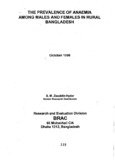The prevalence of anaemia among males and females in rural Bangladesh
Date
1996-10Publisher
BRAC Research and Evaluation Division (RED)Author
Hyder, S.M. ZiauddinMetadata
Show full item recordCitation
Hyder, S. M. Z. (1996, October). The prevalence of anaemia among males and females in rural Bangladesh. Research Reports (1997): Health Studies, Vol - XXII, 195–211.Abstract
This is the first report of a collaborative research project between the Research
and Evaluation Division (RED), BRAC, Bangladesh and the Department of
Epidemiology and Public Health, Umea University, Sweden. The study aimed at
investigating the prevalence · of anaemia among men and women in a typical
Bangladesh rural community. The survey was conducted in a perceived healthy
population in March 1996 in 12 villages of Fulbaria Thana of Mymensingh
District located about 1 00 km north of Dhaka city. One hundred and six males
228 non-pregnant females aged 11-48 years were purposively selected.
Information was obtained on haemoglobin concentration, parasitic infestation
and household socio-economic status. About 69% of males and 70% of
females were found to be anaemic according to WHO anaemia criteria. There
was no difference in anaemia prevalence between males and females. Literacy
and perceived economic status were associated to anaemia prevalence among
females, but not among males. Anaemia was also more common among those
holding little or no land and among those having current ascaris infestation. The
study suggests that anaemia is highly prevalent in the rural communities of
Bangladesh which affects both males and females equally. Further studies
should be undertaken to confirm the findings and also to examine the causes of
anaemia both in males and females in the rural areas of the country in order to
undertake necessary preventive and control measures by the concerned
agencies.

